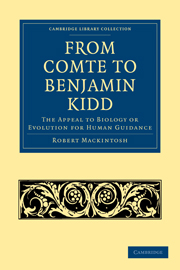Book contents
- Frontmatter
- PREFACE
- Contents
- CHAPTER I INTRODUCTORY
- PART I COMTISM, WITH SOME SCATTERED PARALLELS
- PART II SIMPLE EVOLUTIONISM—SPENCER, STEPHEN
- CHAPTER VII DARWINIAN AND SPENCERIAN CONCEPTIONS OF EVOLUTION—DARWIN
- CHAPTER VIII DARWINIAN AND SPENCERIAN CONCEPTIONS OF EVOLUTION—SPENCER
- CHAPTER IX MR. SPENCER'S THREE DOCTRINES OF HUMAN WELFARE
- CHAPTER X MR. LESLIE STEPHEN'S “SCIENCE OF ETHICS”
- PART III DARWINISM, OR STRUGGLE FOR EXISTENCE
- PART IV HYPER-DARWINISM—WEISMANN, KIDD
- Index
CHAPTER VIII - DARWINIAN AND SPENCERIAN CONCEPTIONS OF EVOLUTION—SPENCER
Published online by Cambridge University Press: 29 August 2010
- Frontmatter
- PREFACE
- Contents
- CHAPTER I INTRODUCTORY
- PART I COMTISM, WITH SOME SCATTERED PARALLELS
- PART II SIMPLE EVOLUTIONISM—SPENCER, STEPHEN
- CHAPTER VII DARWINIAN AND SPENCERIAN CONCEPTIONS OF EVOLUTION—DARWIN
- CHAPTER VIII DARWINIAN AND SPENCERIAN CONCEPTIONS OF EVOLUTION—SPENCER
- CHAPTER IX MR. SPENCER'S THREE DOCTRINES OF HUMAN WELFARE
- CHAPTER X MR. LESLIE STEPHEN'S “SCIENCE OF ETHICS”
- PART III DARWINISM, OR STRUGGLE FOR EXISTENCE
- PART IV HYPER-DARWINISM—WEISMANN, KIDD
- Index
Summary
Mr. H. Spencer's problem is wider than Darwin's, extending, as it does, to the whole of the phenomenal or “knowable” universe. The impulse to it came from two scientific theories of the age. The first was Grove's proof of the correlation of the physical forces, clenched by Joule's determination of the mechanical equivalent for heat. As a result of this, the inorganic world seemed to gather itself together in one, and to manifest its unity as it had never done before. Phenomenally, the differences remained; heat was heat, light was light, electricity was electricity; but it was now proved that some were mutually convertible, and it was henceforth probable that all were so ; it was known that some were modes of motion, and it came to be believed with increasing definiteness that all the others were equally modes of motion. In the invisible world of molecular change it was assumed that these diverse branches combined in one common trunk. The second discovery was Darwin's account of the origin of species. Before this theory was broached Spencer was already on the track of his own thoughts. If it helped him it did so rather by confirming his original bias than by making him a convert to the special peculiarities of Darwinism. In its simplest shape Spencerian evolution is an assertion of the all-sufficiency of natural law, a denial of intervention from outside at any stage in the process by which the universe has become what it is.
- Type
- Chapter
- Information
- From Comte to Benjamin KiddThe Appeal to Biology or Evolution for Human Guidance, pp. 71 - 85Publisher: Cambridge University PressPrint publication year: 2009First published in: 1899

